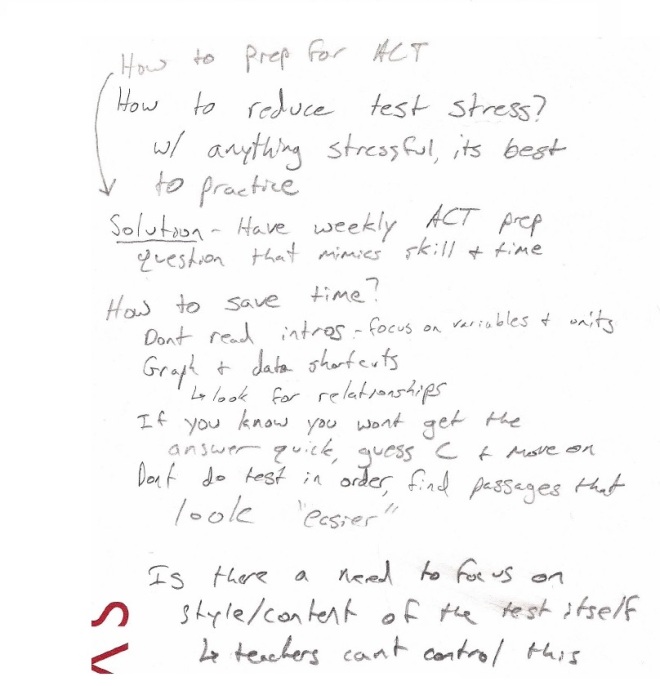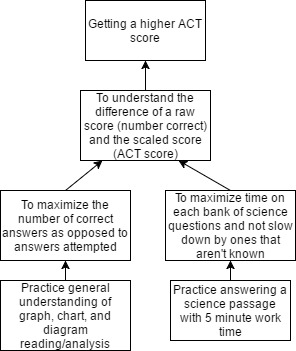Author: Adam Luck
Final Reflection
As the semester closes, I have written my final thoughts about the course and the design process as I move forward in school and in my career. The full reflection can be found here.
Module 7 – Problem of Practice Final Report
As we close out the end of the semester, I have reflected on the design process as a whole. The problem of practice final report can be found here.
Lab 6 – Testing
In the embedded video below, which can also be viewed here, I highlight the test of using a specific strategy to work on ACT skills. This test focuses on graph analysis using research from the Galapagos Islands to frame evolution by natural selection. Ultimately, my main problem is how to increase student scores on the ACT science section? I developed this lesson as one example, or possible solution, to test how to introduce science skills into the class. A more formal test report is featured in a different blog post.
Module 6 – Testing Mode
To test my ideas for increasing ACT scores for my problem of practice, I developed a lesson plan that focuses on graphing skills. I performed this lesson myself as well as shared it with a colleague to gain more feedback. I detail the actual lesson in a different blog post. The purpose of this post is to reflect more on the lesson itself after interviewing my coworker to gain more insight to the strengths and weaknesses of this solution. The full test report can be found here.
Module 5 – Prototype Mode
For my Problem of Practice, raising science scores on the ACT test, I have moved into the prototype mode, which can be found here. Ultimately, I cannot construct something concrete that can be handled. What I decided to do was create a write up, or outline of sorts, that highlights the major strategies to be used through out the course of a high school career to better prepare students for the science section of the ACT. The development of the outline was a useful strategy to begin thinking about how to “solve” this problem. I may have started to get into more details than I intended to, but as I was researching and analyzing previous ACT test scores from my own building, I wanted to get common errors with solutions down on paper. Just as practicing the different stages of creating a solution for this problem of practice, students should get the opportunity to practice the skills used towards the test as often as possible but still within reason of a teacher’s curriculum. What is convenient about practicing for the science section of the ACT is that it makes for an overall “better” scientist because the skills are transferable.
Lab 5 – Connected World
My prototype representation as depicted here is for the idea of the connected world. The idea came to me quickly enough, grab a bunch of devices that are used to connect people to other people. My initial thoughts were to grab communication devices, phones, computers etc. and connect them using string. As I was going around the  house collecting devices from family members, I walked past a Bluetooth speaker and thought, devices don’t just connect people, they also connect to each other. So I gathered a few device to device pieces like the speaker, television remote, and car keys. As I was unplugging the phone from the outlet, I realized I have ready made string right here in the power cord. The cords also act as a physical connection either between devices, headsets, or outlets. Though my prototype didn’t change much from start to finish there were slight evolutions that naturally happened through the gathering and creation process that allowed for a wider consideration of what it means to have a connected world.
house collecting devices from family members, I walked past a Bluetooth speaker and thought, devices don’t just connect people, they also connect to each other. So I gathered a few device to device pieces like the speaker, television remote, and car keys. As I was unplugging the phone from the outlet, I realized I have ready made string right here in the power cord. The cords also act as a physical connection either between devices, headsets, or outlets. Though my prototype didn’t change much from start to finish there were slight evolutions that naturally happened through the gathering and creation process that allowed for a wider consideration of what it means to have a connected world.
Problem of Practice: Ideate Mode
Brainstorming – This week, to problem solve some solutions for my problem of practice of raising science scores on the ACT test, I held a brief brainstorming session. The session included myself, an advertising executive, and a librarian. The session focused on 3 major ideas: Commentary on schools, commentary on the test itself, and strategies for doing better on the test. I typed up the full brainstorming session notes which can be found here.
Incubation – After the brainstorming session, I spent a few days jotting down some ideas that would come up, otherwise known as the incubation period. A significant idea I took from the brainstorming session was the “desensitize students to test stress”. A lot of my follow up thoughts revolved around this idea. I have attached my incubation ideas below:

Reflection – Reflecting on the process of ideation, I think I found a lot of value talking to people outside of the teacher community. They were able to give me viewpoints without being filtered through the professional teacher sieve. While there was quite a bit of focus on how “bad” of a test the ACT is, they were able to bring in some ideas that I had not necessarily considered. I was thinking about solutions for students so that they could perform better, what this brainstorming helped reveal were some potential issues as to why students get the scores they get. This helps because if you can understand a cause, then you can more narrowly focus on a solution. This whole process has helped me confirm that I am on the right track. For students to perform better, they need to feel more comfortable taking the test. To be more comfortable taking the test, students need to be able to handle the stress. To handle the stress, students need to learn strategies, skills, and shortcuts to help maximize time and minimize error.
Module 4 Lab Activity
In this weeks lab activity, I attempted a thinking strategy that has you come up with as many thoughts as possible, take a break, and then come back to the problem. My problem that I was ideating for is how to raise student scores on the science section of the ACT. My thoughts can be found here.
Problem of Practice – Define Mode
Part 1A 5 Why’s:
My 5 Why’s of my Problem of Practice-
Problem: Students are getting low scores on the science section of the ACT.
Why?
Students are rushing to complete the test and make silly errors.
Why?
The science section is the last of four tests and is made up of 40 questions to be answered in 35 minutes. Students run out of time.
Why?
Students are not taking shortcuts to help maximize their time and scores.
Why?
Students aren’t aware how to maximize their time and scores.
Why?
Students aren’t being taught strategies how to maximize their time and scores on the ACT test.
Part 1B Why-How ladder:
This is a Why-How Ladder to help define/answer my problem of practice-

Part 1C Point of View Activity:
My Point of View Madlib –
Students need to increase their ACT scores because we’re running out of time!
Part 2 Problem Statement:
My problem of practice that I am focusing on is how to increase student scores on the science section of the ACT. I teach at a private secondary school in Metro-Detroit Michigan. One of our school’s goals is to improve our scores on the ACT test. Since I am a science teacher, I am focusing on the science section. One of the major issues with the science test is that it is the last test out of four and is composed of 40 questions that are to be answered in 35 minutes. After analyzing tests and some of the basics of how ACT scores are calculated, there are two major areas of improvement that are linked very closely to each other. Students are either running out of time on the test and are left with just filling in bubbles, or students are making simple analysis mistakes by reading charts/graphs wrong in an effort to get to the end of the exam. By reinforcing test skills and practices on the exam, I hope to improve student outcomes.
